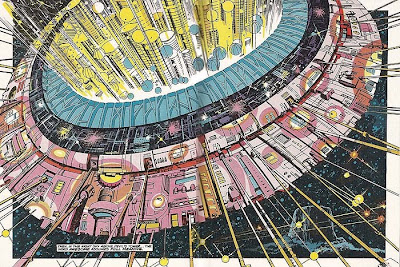 Some properties are moving well in a comic format. Others do not.
Some properties are moving well in a comic format. Others do not. is what happened with MARVEL SUPER SPECIAL # 3: CLOSE ENCOUNTERS OF THE THIRD KIND and difficulties involved in adapting this type of project.
The film was quite a fantastic atmosphere right fusion, sharing, dialogue, locations, music, effects, sounds and no longer to say. If you know, there it was.
The task of adapting all this classic of modern fantasy at the time fell on the shoulders of the writer Archie Goodwin and artist Walter Simonson who were supported by Klaus Janson inked and the production of Marvel editorial. While
 have existed before comic adaptations have doubled some film and photos taken in the final art in this special issue appeared that most of the character designs and props were created by their own.
have existed before comic adaptations have doubled some film and photos taken in the final art in this special issue appeared that most of the character designs and props were created by their own. Al browse all the special, one could not immediately locate Richard Dreyfuss, Teri Garr or Francois Truffaut.
Marvel and his team tried to replicate the most forceful in words and graphics that everyone saw and heard on the big screen in your area.
An impossible task.
They can not be criticized for not fulfilling the expectations to be 100% satisfied with their readers who were accustomed to mentally compare movies with comic adaptations.
 And this was a case where the spectacle of a film of this type with a soundtrack by John Williams, may predispose a reader to seek more failures than successes.
And this was a case where the spectacle of a film of this type with a soundtrack by John Williams, may predispose a reader to seek more failures than successes. In the past, and probably remains in our mind with greater emphasis, publishing companies usually pay extra money to obtain the rights to use the likenesses of the actors in their film adaptations.
 To highlight the issue here, at the same time that Marvel had the rights to publish the cartoons THE WARS, were included rights to use the likenesses of the actors who appear in the movie.
To highlight the issue here, at the same time that Marvel had the rights to publish the cartoons THE WARS, were included rights to use the likenesses of the actors who appear in the movie. For the adaptation of "Close Encounters of the Third Kind" Marvel did, the deal did not include rights to use the likenesses of the actors involved in this film.
That explains why the character of the "hero" Roy Neary and all others, were quite different from one he had seen in movies.
rights situations in adapting TV series and movies are often complex and not necessarily well understood by people not working in legal departments.
As seen in this special Marvel Illustrated, the film makers and film studio executives Columbia were very nervous about releasing any information that includes images, before the movie premiered in theaters.
 As a result, the official script was delivered to them was to adapt Goodwin and Simonson was not very full and had to work with little or no support from the owners of the film.
As a result, the official script was delivered to them was to adapt Goodwin and Simonson was not very full and had to work with little or no support from the owners of the film. According to statements from both creative, they were shown several photographs, a short excerpt from the scene with the UFO flying over county roads, they showed some notes and pictures of pre-production, but basically was a series of things that are allowed to take outside the studio.

was definitely a case of memorizing it and then go to work with retained in their brains. Simonson said he managed to let him make some quick sketches and that was it.
While they worked without the support of the studies, Goodwin and Simonson admitted having received help from friendly people.
Persons not related to the study or directly responsible for the film and managed to watch a special presentation of the film before its official release (a creative presentation that the duo could not see) helped them a bit to describe certain things to incorporate material from his script, being able to show in the beginning and end of the film adaptation, which exceeded their expectations.
It was a year of working in the dark to make out a comic book adaptation that despite the setbacks, ultimately what wanted was to be a presentable reading.
Written by Hector Augusto Sovero Gastañeta.
0 comments:
Post a Comment